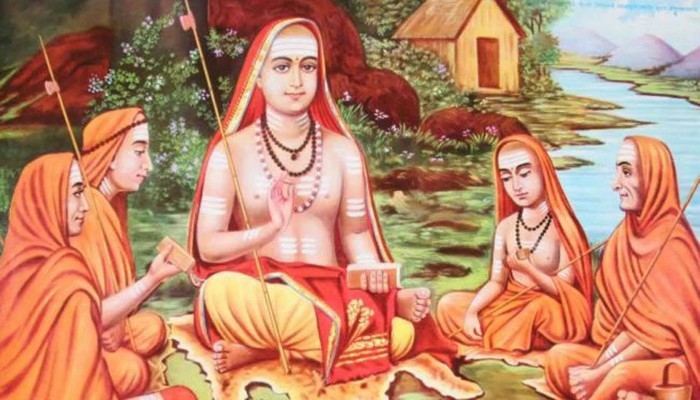Shankaracharya Madhyamam Part-2
- In Religion
- 10:36 AM, Mar 19, 2021
- Raghu Bhaskaran
Shankara Mutts and Historical Popularity
Let us leave Shankara himself aside for a moment and see if there is evidence about the influences and impact of Shankaracharya Mutths or Advaita, in history.
Again, there is little to indicate that they were influential. There is a tendency to compare them with other Vedanta schools – Madhva Dwaitha or Ramanuja Vishishtadvaita, but that is an incorrect comparison. Because it was streams like Shaiva, Vaishnava, Shaktha etc which had mass following and sponsorship. Vedanta of any variety until recent centuries, there is little evidence that they were popular among the people or the kings.
Yet, given the overlaps, folks will argue that Shankara-Shaivam or Vishishtadvaita-Vaishnavam were popular, but that is a weak argument.
Here are my reasons on why even the Shankaracharya Mutts can’t be considered influential for a long time.
Location
Shankara Mutts are located in places, which for long were not epicentres of Indian history, not Hindu knowledge centres or capitals of kingdoms etc.
The early success of Buddhism lies hugely in its location. Rajagriha was the capital of those times. Major kings and merchants sponsored Buddhism.
Southern Shaivam flourished in Kanchi and Madurai, both major capitals, Nayanamaars explicitly turned Pallavas and Pandyas away from Buddhism and Jainism.
But Shankaracharya Mutts were in locations, which had religious significance as Kshetras, but otherwise were not population centres in history.
- Badri - Badrikashrama - only pilgrimage, inaccessible to most.
- Dwaraka - Dwaravathi - only pilgrimage, not a population centre, since the times of Krishna
- Puri - Jagannatha Puri - only pilgrimage, until the Chodagangas around 10th century CE.
- Shringeri – Legendary, but was it even a pilgrimage destination until Shankara Mutt was established?
If Advaita was to be an influential school, then why not Kashi, Ujjayini, Rajagriha?
Kanchi – like with the dating of Shankara himself, I will sidestep the debate whether the Kanchi Mutt was established by Shankara or not.
Kanchi was definitely a prominent centre of ancient India, teeming with Shaiva, Vaishanava, Jaina, Bouddha Sampradayas, the famous Gatika, teaming with poets and philosophers like Dandin, Vedanta Desika etc.
Yet outside of Shankara Mutts literature I have not read any inscription or non-religious references to the presence of a Shankaracharya Mutt in the city. Nothing from Pallavas or Cholas.
Mahendravarman in his Matta Vilasa Prahasana, makes fun of the prominent sects in his city - Kapalikas, Pasupatins, Buddhists, Jains, but no mention of Vedantins, Mayavadins etc.
So, I do not say that the Shankaracharya Mutt did not exist in Kanchi. But merely saying that even if it did, it does not seem to have been of any noticeable popularity or influence.
While gurus of different Shaiva/Vaishnava sects, were held as Raja-Gurus of kings, nothing of the sort about the Vedantic gurus like Shankaracharyas.
That changes only around 1300s, with the advent of Vijayanagar, the two prominent cases where Shankaracharyas are recorded in non-religious history are,
- Vidyaranya mentored the Sangama brothers to establish Vijayanagar, that is recorded in the evidences from Vijayanagara
- Maratha irregulars raided the Mutt during Tipu's usurpation of Mysore.
Do we have any other independent evidence from sources other than the Shankara Mutts, about the existence of the Shankara Mutts?
- Some king or chief recording a donation?
- Some Buddhist, Jain or Veera Shaiva literature about debating/meeting with the Shankaracharya
Be it with Shringeri, Dwaraka, Puri, Badri or Kanchi Mutts. I am not aware of any such historical interactions of Shankaracharya Mutts, with non-religious entities or other traditions.
Even after Vijayanagara, other Vedantic Mutts were also prominent, even more than Shankaracharya Mutts in many cases. Rayas of Vijayanagar itself, took Madhwa Seers like Vyasaraya Teertha as their guru.
Followership
This is speculative, the following of Shankaracharya Mutts seems almost nearly from the Brahmanas, until the recent centuries. I will acknowledge that among Hindus, this is a metric very difficult to establish, given that Hindus are not ‘exclusivist’ in nature and will respect a variety of Acharyas. But a reasonable measure will be to check for Kula Gurus. To the extent of my reading, I have not come across any community having a Shankaracharya Mutt as the Kula/Kudumbha Guru, other than Brahmins.
Even if there, still the non-Shankaracharya or non-Vedantin schools, would have more families acknowledging them as Gurus. This is purely speculation and I don’t have any statistical evidence to back this up.
And this about those who follow the traditional Shankara Mutts, not the modern ones of Ramakrishna Mission, Chinmaya Mission etc.
Given that Brahmins always were a miniscule population among Hindus and further that not all Brahmins in Shankara’s own time or even in the centuries after, would have been Advaitins.
So, by followership, I doubt if Shankara-Advaita was significantly influential, among the many competing schools’ extent at different points in history.
Language
Shankara’s compositions and those of Shankara Mutts are for the most part in Sanskrit. Whereas most Bhakthi literature were in the vernacular languages of the different regions of India. And language is a major factor when it comes to mass following.
So that is an indicator that Shankara, Shankara Mutts could not have been more popular than the various Bhakti streams.
Yes, the Bhakti streams themselves incorporated Advaita philosophy in their wonderful literature, but while measuring popularity that can’t be taken as a factor.
Hence it would be incorrect to assume that Shankara-Shankara Mutts were popular institutions in history, measured against Bhakti movements or other Shaiva, Vaishnava institutions.
Shankara and modern popularity – Neo Advaita
Yet today, Advaita is probably the most popular Hindu school in popular perception.
This can be traced to the Colonial age, contact with the West, and Advaita gained popularity for the following reasons,
Advaita’s monism can be easily, but incorrectly recast as monotheism, with its emphasis more on the Nirguna Brahman, incorrectly equated with the Abrahamic God, with a misconception that Advaita does not promote rituals, customs etc.
It got more traction among the Colonial society. Similar thing happened with Buddhism. And Westernized Hindus sucked up, "Hey look, we also have something which is not ritualistic, not superstitious and purely philosophical as well"
I call this genre of misrepresenting Advaita or any Hindu cultural or philosophical aspect, to conform to outsider expectation as ‘Taqqiyography’. Works, narratives, opinions by people from Hindu background, who seek to force fit the Hindu worldview, to pander to Islamic or Christian expectations.
Some characteristics of this genre are-
- Advaita will be presented as monotheism
- Murthis will be underplayed as mere representational aides for the intellectually unevolved
- Any Hindu assertions of political, social legitimacy will be deplored as un-Hindu with cherry picked platitudes like "Ahimsa Paramo Dharmah", "Vasudhaiva Kutumbakam" etc.
- Hindus will be treated as captive markets and solely responsible for secularism, pluralism, inclusiveness etc. Expecting them to yield and yield to intransigence, exclusiveness and dogma, dosed with ARSEnic (All Religions are Same and Equal)
- While no criticism will be made of Christian inculturation, values of Hindu heritage like Yoga, Ayurveda, Bharatanatyam etc will "out-cultured", i.e., secularized and presented as independent of the faith and belief system
A pioneer in this Taqqiyographical genre was Ram Mohun Roy, and his work was suitably titled "The gift to Monotheists".
This triggered movements like Arya Samaj – puritanical, monotheistic and missionary, which continue even today with the Agniveers, who seem to want to burn the entire forest of Dharma which has sprung up from the seeds of Vedas, in their attempt to go back to the Vedas.
But also, others like the champion of neo-Advaita, Swami Vivekananda and the Ramakrishna Mission.
Responding to the Colonial and Monotheistic challenge, this version of Advaita, Swami Vivekananda took to the Western shores itself and won adherents. Given the psyche of colonized Indians, who will appreciate anything once it is appreciated by the West, this gave a massive boost to the popularity of Advaita and Shankara.
Resulting in a lot of myth making around Shankara, with him being cast as some kind of prophetic figure who single-handedly 'Saved Hinduism' and building an impression that
“Hinduism is only Vedanta, and Vedanta is only Advaita.”
A patently false and a damaging narrative to the diversity of Hindu worldviews. Yet indulged in a manner so reminiscent of other monotheists, that I am tempted to call the fanatic cases as “Allahdvaitins”.
It is not just over-enthusiastic people who advance this fallacy, but also powerful entities like the Supreme Court of India, which has in instances used Swami Vivekananda as the referential authority, like the definition of religion, caste stratification, overseas travel etc. While these may look beneficial at the obvious level, it entrenches Neo-Advaita as the sole representative of Hindu religious views, which would be no less an attack on the diverse traditions of Dharma, than a medieval Islamic invasion. Swami Vivekananda can be an authority only for his one sampradaya - Ramakrishna Mission and those who willing accept his views. He should not be imposed upon all Hindus. Nor should Shankara, Ramanuja, Chaitanya etc.
Nevertheless, with the two monopolistic religions targeting the Hindus as an open market and the traditional defenses of Dharma shut down in the colonial age, and today as well under the Secular Sultanate of India, Shankara’s Advaita gives many advantages to compare, compete and consolidate the Hindus as compared to other options.
Some of those aspects are creditable to Shankara and others are misinterpretations.
The misinterpretations are of course the ones listed as Taqqiyography.
- Monotheism: There is a creator, separate from his creation Vs. Shankara Advaita: Monism, there is nothing but the Brahman, the creation is an illusion.
- Rituals are nonsensical superstitions Vs.Shankara Advaita: Karma Kanda, rituals are valid steps, for Chitta Suddhi towards Advaitin Moksha.
- Deities are just idols, false gods. Vs. Shankara Advaita: Ishwara as Saguna Brahman is worthy of worship-upasana
An argument will be made that Shankara only accommodated Karma Kanda-rituals, Saguna-Ishwara to win adherents to his path. He actually himself was not convinced by them. But that is just modern-day Hindu Taqqiyographers projecting that Shankara was also a Taqqiyographer in his day to win adherents. Either way speculative.
But there are things that Shankara achieved, which are factual and make Advaita far more acceptable in the present age, compared to other Sampradayas.
- Non-Exclusivity: While most other sampradayas get associated with one deity/devata - like Madhwa, Ramanuja got almost entirely associated with Vishnu, Shankara by recognizing Panchayatana/Shanmatha, is acceptable to larger population groups, who have different upasana deities.
- Regional vs. Pan India: Most Sampradaya founders like Madhwa/Ramanuja primarily operated and found traction in the region and communities they were born in. Only over time did their influence spread slowly with migrations and other dynamics. Somewhat like Buddha, who also stamped around only in his region of origin, but later missionary activity made Buddhism global. But Shankara in his own time, was pan-Indic in his activities, which again makes him more acceptable to all Hindus.
So, Hindus had two options to respond to the invasive religions,
- Use the more liberal and inclusive Shankara-Advaita, where the personal god is interchangeable and has pan-Indic legacy
- Use more exclusive sampradayas, where personal god is paramount, to compete with the illiberal and dogmatic.
And currently there appear to be more takers for the first approach.
Though I wonder about this, it invariably takes a dogma to defeat a dogma. And Advaita’s characteristics which seem the advantage in the social consolidation of Hindus, are also its weaknesses.
- If personal god is not paramount, why not accept YHWH or Allah as other forms of Ishwara and Jesus, Mohammed as Avataras, Acharyas?
- Why be only pan-Indic, why not be global by accepting Jesus and Mohammed?
Hence resulting in Advaita creating more ARSEs (All Religions are Same and Equal), than other sects, Ramakrishna Mission or other Corporate-Gurus celebrating Christmas, complimenting Christ, praising the Prophet etc.
This defeats the whole socio-political purpose of consolidating the Hindus against the invasion by intransigent invasive religions.
The challenge in using Advaita for socio-political purpose, is to educate the followers in operate in two levels,
- Paramatmika/Spiritual - unifying, inclusive, non-discriminating etc., where identities do not matter, there is no competition etc.
- Vyavaharika/Social - competing, protective and discriminating etc., where identities do matter and values to be protected.
Not an easy thing to achieve.
Shankara and Social Reform
When comparing Neo-Advaita with Shankara’s Advaita, I have mentioned the alignments and the misrepresentations. But there is one major aspect that is the primary sticking point for the reformist Neo-Advaitins.
Shankara does not reject Varnashrama and birth-based stratification, whereas Neo-Advaitins strongly reject it.
Which leads to amusing situations, where folks will be claiming,
- I adulate Shankara Bhagavadhpada, he saved Hinduism, was the superstar of Vedanta Advaita, single-handedly Thanos-Snapped Buddhists from India.
- I admire Swami Vivekananda, he saved Hinduism, was the rock star of Vedanta Yoga, single-handedly made Hinduism, a 'cool' thing to wear on the sleeve.
But get stumped when asked, what about the criticisms Swami Vivekananda had about Shankara?
Have you noticed, Shankara is one Hindu religious icon, who is never feted of being a 'Social reformer', whereas with pretty much everyone else it is 'Social reform' that is highlighted and their Bhakthi or philosophy are kind of beside the point.
- Basaveshwara - he led candle lit marches against Brahmanism, great reformer. Never mind his bhakti, that is just sentimental sap,
- Ramanujacharya - oh he ran an NGO full time, called Ashtakshara Activism. Never mind his Vishishtadvaita, it is not as erudite as Voltaire.
The Hindu Dharma Continuum is like the waters of a perennial river. And to claim someone as a Hindu social reformer, is like claiming someone gave a different shape to 'water'.
This is often alleged of Bhakti saints, that they were social reformers, so much is made of it, that one would think that their Bhakti itself is just an irrelevant detail.
The reason for this blurred vision, is of course as usual looking at this worldview with the borrowed Abrahamic lenses. When the primary 'form' is a book, supposedly of God's words, then every divergence from the book or interpretation can be seen as reform.
But what is the form for Dharma, Vedas with inbuilt skepticism like asked in Nasadiya sutra, that there can be considered reform?
Dharma is a limitless ocean, of course with many currents, counter currents etc. But the intent is always towards the Sat-Chit-Ananda.
Social reform is mere froth, a by-product which was never the primary intention of any of the philosophers, seers or saints. Their vision was simply that the social structures are no impediment to seeking the divine.
They never held that 'Social structures have no relevance, to the pursuit of prosperity and power', but just that Social Structures are no impediments to spiritual seeking'
Height and build are indeed of no relevance in Mathematics, but it is idiocy to apply it to basketball.
Similarly, in seeking the divine, with multitude of methods, indeed caste/social stratification are of little relevance, but that is only to the seeking of the divine, not for economics or other social activity.
In any case, Shankara generally is spared of this ‘Social Reformer’ label, Colonial-Marxists prefer to have him as the icon of Brahminical oppression, so the Neo-Advaitins have a hard time countering that.
They end up misrepresenting the Manisha Panchakam episode, where Shankara was taught a lesson by the Chandala and bowed to him. Completely ignoring that the Chandala asks the question correctly, differentiating between the Spiritual and Social/Material. Again, failing the aforementioned challenge, of using Advaita at two different modes.
Summary
Shankara is no more just a genius philosopher or an avatar for the devote, an iconic figure who reorganized Dharma across Bharata etc., but has become a cultural symbol of a civilization, still struggling to decolonize itself and raise up from centuries of suppression.
For those whose seeking is enlightenment, at a personal level, he is a bright star among the stellar galaxy of Dharmic Mahapurushas. However, the details surrounding him, historic dates, historical impact, contemporary impact, alleged achievements are often fake and unnecessary ornaments foisted on his legacy.
Shruti Smriti puranam alayam karunalayam
Namami Bhagavatpada Shankaram Lokashankaram
Image Source: DailyO
Disclaimer: The opinions expressed within this article are the personal opinions of the author. MyIndMakers is not responsible for the accuracy, completeness, suitability, or validity of any information on this article. All information is provided on an as-is basis. The information, facts or opinions appearing in the article do not reflect the views of MyindMakers and it does not assume any responsibility or liability for the same.







Comments